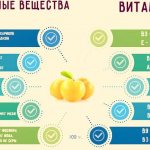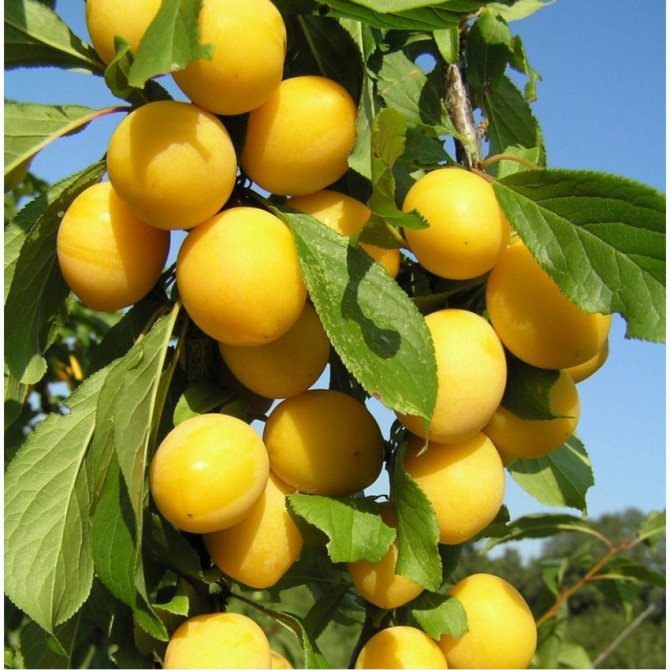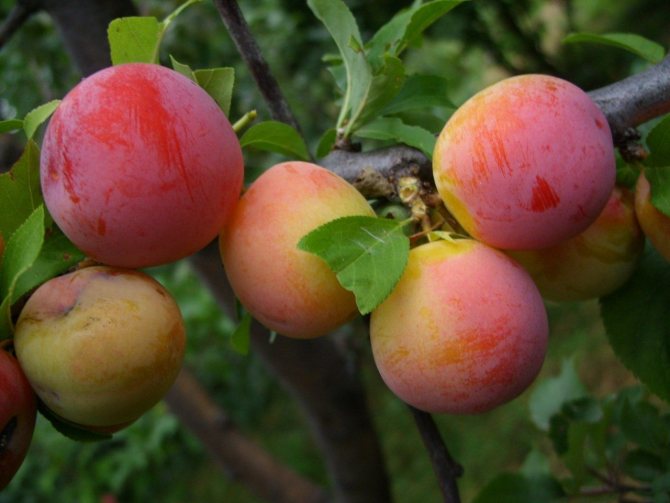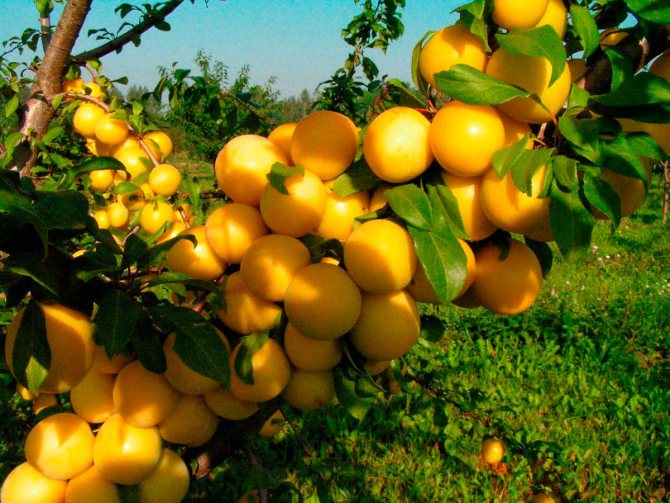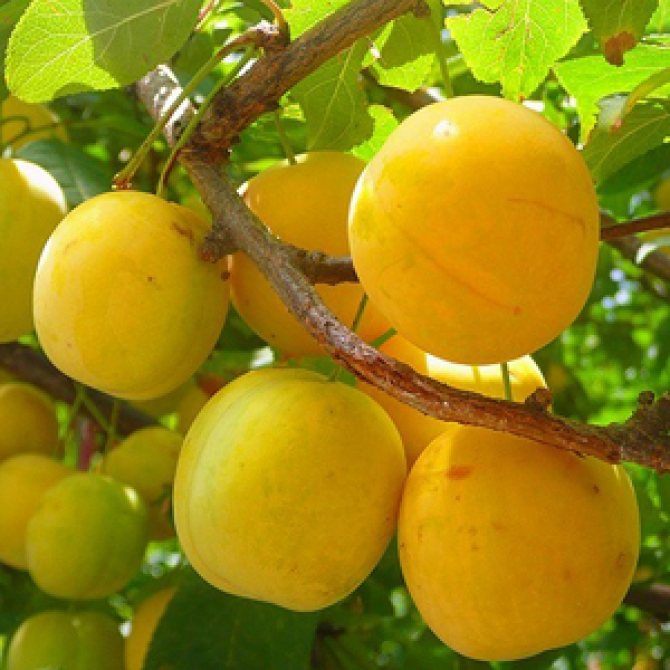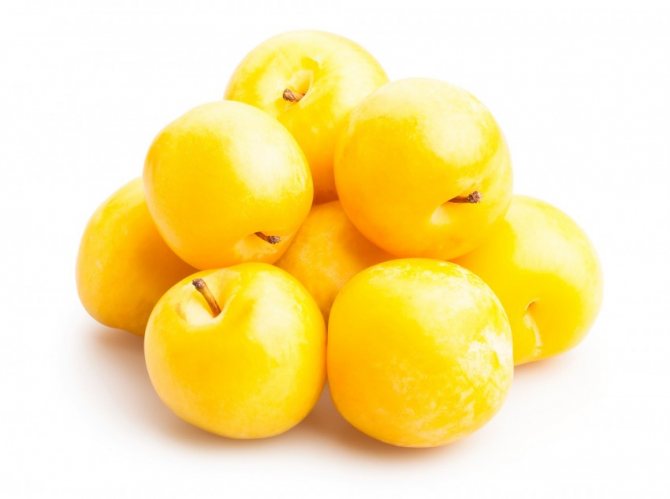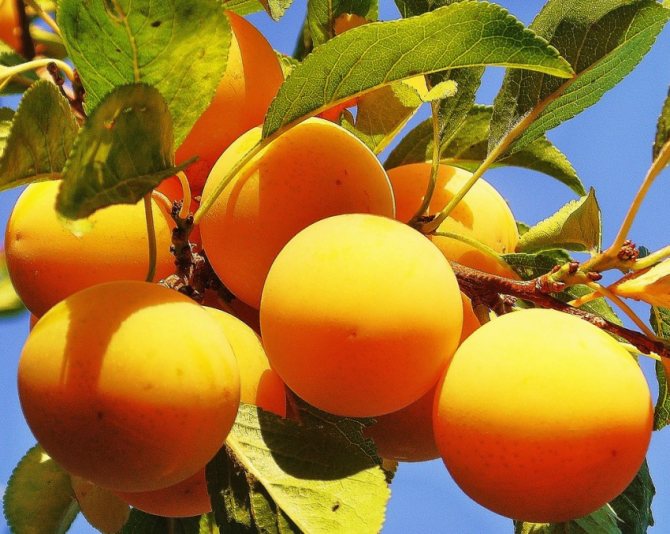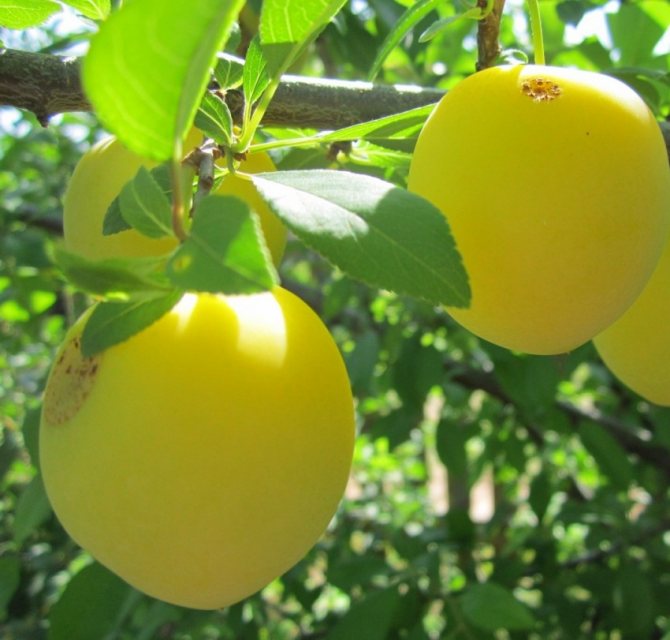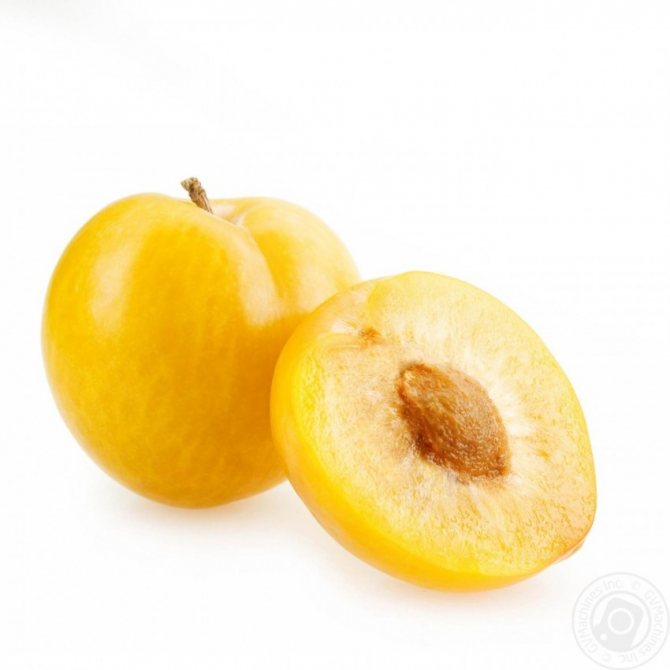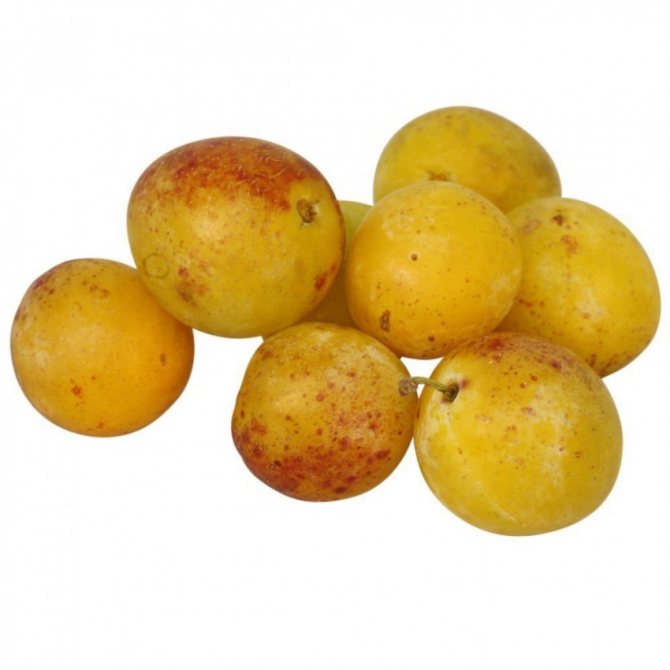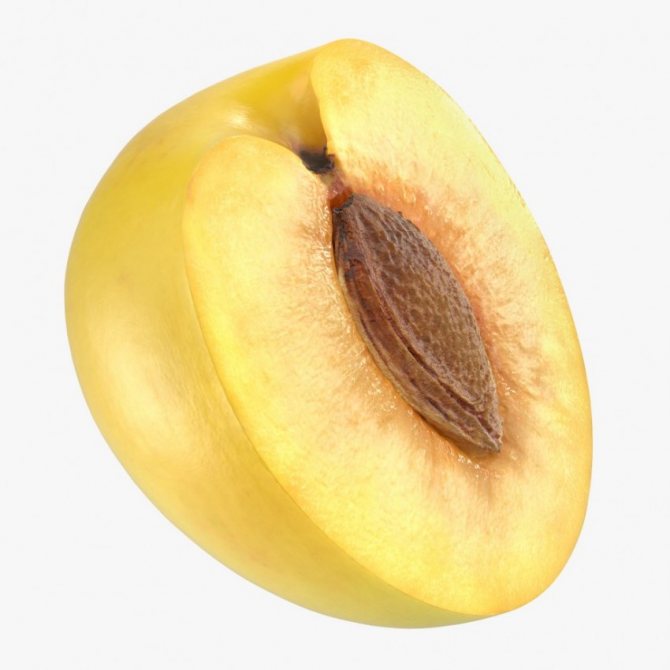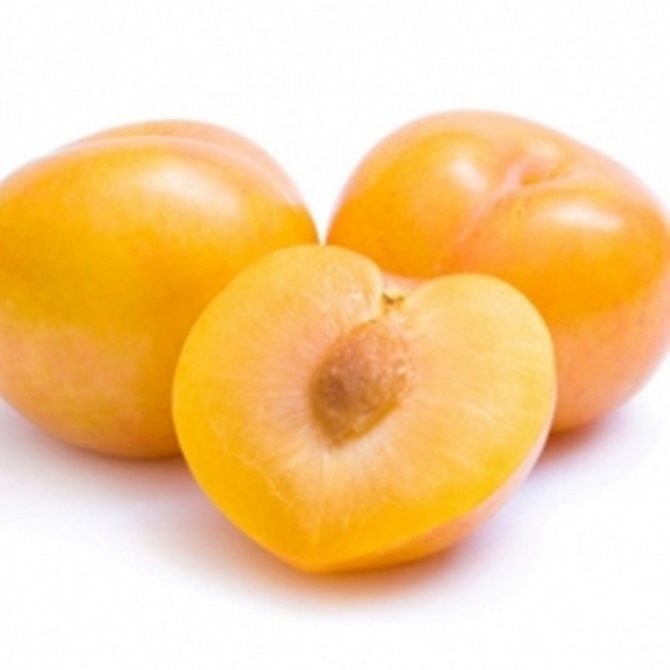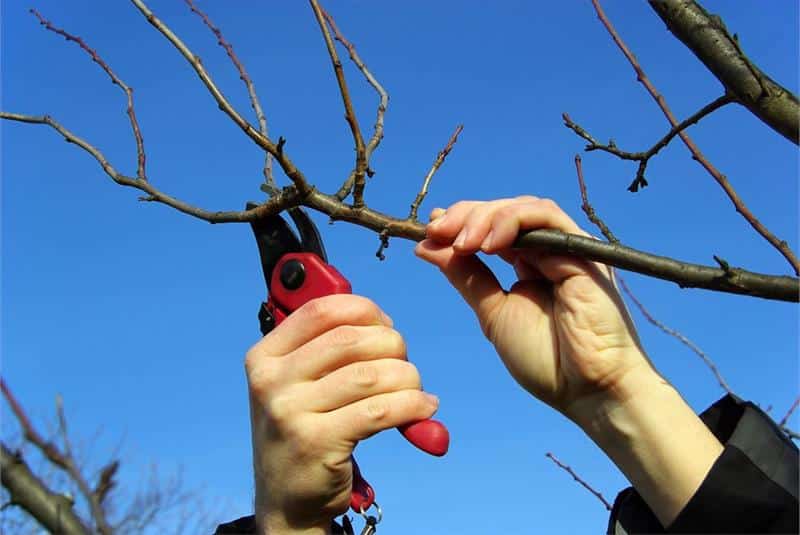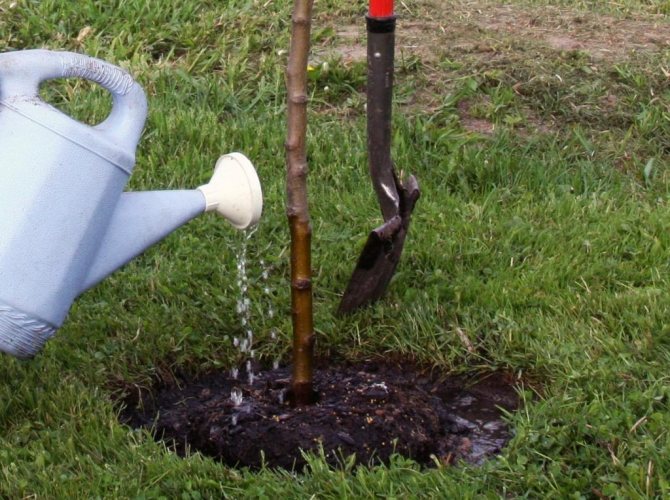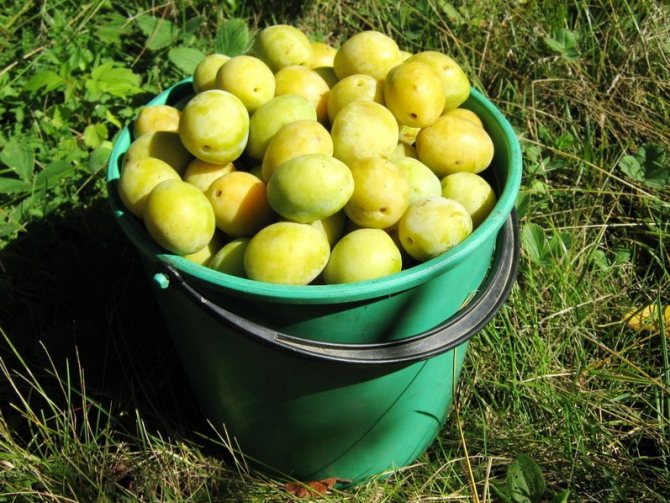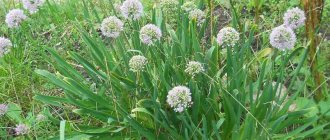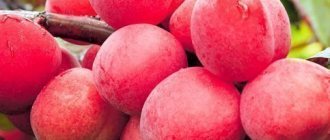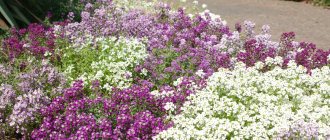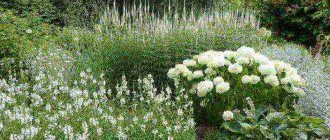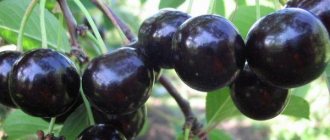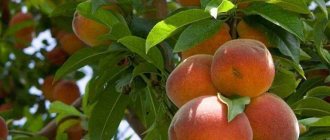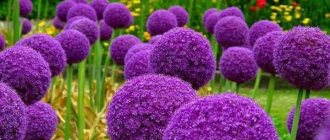Yellow plum contains many vitamins and nutrients. Its fruits are used fresh and canned. Jam, marmalade and jam can be made from aromatic plums. Today, there are many varieties of crops intended for cultivation in the Moscow region, in the southern regions of the Central Black Earth Region, in the Crimea, as well as in the Far East, Siberia and the Urals. This type of plum, like all other fruits, has beneficial and harmful properties. Therefore, it is necessary to use yellow fragrant fruits taking into account the state of the body.
Features of yellow plums
Mostly all varieties of yellow plums have round fruits, less often oval ones. Their yellow color is the main one, but there may be a red blush or green tint, depending on the variety. All types of yellow plums are divided into groups depending on the ripening period of the fruit.
The most popular varieties of yellow plums are in East Asia. There, winter preparations are often made from them. Every housewife should know the recipe for tkemali, juice, canned fruits in its own juice and other dishes from yellow plums. Yellow plums may taste slightly different during preservation. Depending on what is added to them, the final dish turns out to be sour, sweet, salty or spicy.
Useful and harmful properties of yellow plum
Plums with a yellow rind are characterized by increased sweetness. This fruit contains about 49 kcal (for 100 g) and includes:
- 9.6 g carbohydrates;
- 1.5 g fiber;
- 0.8 g protein;
- 0.3 g fat.
The most important thing for the human body is the presence of potassium and iron, vitamins A, groups B, C, D, E and K.

- This composition determines the useful properties of the product:
- normalization of metabolism and stimulation of digestion;
- production of gastric juice (for those who have low acidity);
- an increase in hemoglobin in the blood;
- normalization of the gallbladder;
- prevention of thrombosis and osteoporosis.
Plum is also used in cosmetics. Fruit pulp refreshes tired skin and has a rejuvenating effect. However, there are a number of diseases in which the consumption of plums is undesirable.
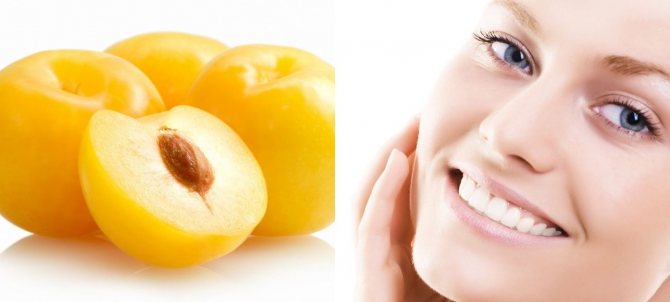

- These include:
- diabetes mellitus and obesity;
- rheumatism and gout;
- gastritis with high acidity.
Description of the best varieties of yellow plum


Photos of the best varieties of yellow plums
Yellow plum can have a wide variety of characteristics. The best varieties of yellow plums are those that have a pleasant taste, high yields and strong immunity.
- "Yakhontovaya" Is a fast growing variety of plum. The tree grows up to 5.5 meters in height with a neat, sparse crown. Fruiting 3-4 years after planting. Flowers are not damaged during recurrent frosts. The variety is resistant to many diseases and pests. The harvest ripens by the end of summer. Each tree can be harvested up to 50 kg. Ripe fruits have a golden, dense skin with a speckled blush on one side. Fruit weight - 25-35 g. Spherical shape. The pulp is golden, with a high content of juice.
- "Yellow ball" or "Golden Ball" - a plum that tastes like a peach. Fruiting occurs at 3 years. The tree grows up to 5 meters high. Inflorescences consist of 3-4 flowers. During fruiting, the branches are almost completely covered with fruits.Frost resistance up to -50 degrees! Fruits are yellow, weighing up to 60 g, with a dense skin, can be stored for a long time, transported over long distances. The yield is high, so sometimes you have to put a support under the branches.
- "Yellow Afaska" - early-growing, Bulgarian variety. The first crop can be harvested in the second year after planting. Fruits are large, weighing 60-70 g. Dessert taste. The color of the peel is yellow with a green tint. The tree is self-fertile, therefore it needs pollinators. The best pollinator for this variety is the Amers plum. Has a strong immune system. It is used more often fresh, although it is not difficult to find a recipe for the winter from this variety.
- "Honey yellow" or "Honey white" refers to tall varieties. The tree grows up to 6 meters. Fruits are in the form of an oval, weighing 50 g. The peel is yellow, with a waxy bloom, an orange blush may appear on the sunny side. The flesh is greenish to yellow, sweet, with a honey aftertaste. The aroma is also honey. The stone is well separated only in ripe fruits. There is a strong immunity to diseases, drought resistance, keeping quality, transportability, but to obtain large yields, it is necessary to plant pollinators.
Features of planting and care
A one-year-old tree is planted in a well-lit, windless, slightly elevated place, where underground waters do not come close (no closer than 1.5-2 m) and where fertile soils prevail (acidic soils are contraindicated for plums).
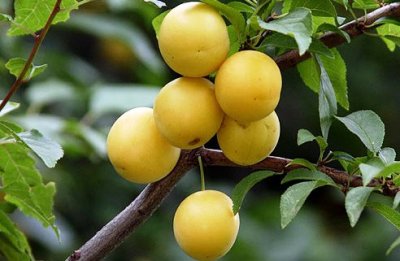

A hole 50 cm deep and 80 cm in diameter is dug for planting. Before planting, the hole must be allowed to settle for 1.5-2 weeks.
After filling the root system with a soil mixture, to which organic and mineral fertilizers should be added, the root collar of the seedling should rise 5-6 cm above the ground surface. The trunk circle is watered with 3-4 buckets of settled water and covered with humus or peat mulch.
Plum care "Yellow Hopty" practically no different from the technology of caring for any other plum plant. It includes regular loosening of the soil near the tree, weed control, watering.
Learn more about other varieties of Chinese plum: Orlovskaya Dream, Ksenia, Skoroplodnaya, Alyonushka.
Moreover, in the dry season, 1 sq. m of the projection of the tree crown, 1 bucket of water is used. Young trees require (especially during dry periods) more frequent irrigation than mature plants.
Much attention must be paid to the correct fertilization of the plum. To obtain good and regular yields, it is recommended to apply top dressing in the form of 3 kg of manure (compost) per 1 sq. m of the near-barrel section.
For optimal fruiting, the tree needs regular pruning. And from severe frosts, young growth in the first 3-4 years of life is advised to be covered with burlap, which is wrapped in 2 layers around the trunk.
Large-fruited varieties of yellow plums
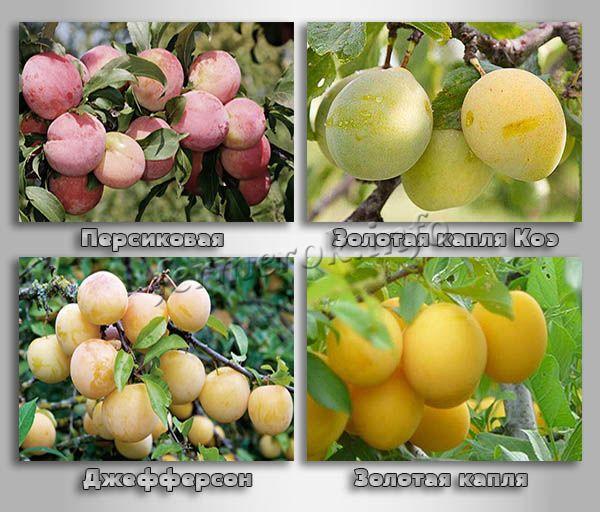

Large-fruited varieties of yellow plums
Large plums are easy to handle and popular for sale. They are easy to pick from the tree, even if it is tall, and they store well. What are the best varieties with large fruits that deserve the attention of gardeners?
- "Peach" - an early variety of plum with large fruits of 50-70 g on average. The tree grows of medium height, about 3-4 meters, the crown is not dense, but requires thinning. The cream is round, may be slightly elongated. The rind is dense, yellow with a green tint and a blush on the sunny side. The pulp is firm, but juicy. Thanks to these qualities, the variety is suitable for long-term transportation. The taste is sweet and sour, so it can be used for the recipe of plum tkemali or similar dishes.
- "Coe's Golden Drop" Is an English variety. The fruits ripen by the end of August. The tree is medium-sized, with a spherical crown. A fast-growing, fruitful species. Fruits weighing 50-70 g, oval. The rind is golden, there may be a green tint.On top there are stripes or specks, as well as a thick coating. The taste is dessert, the pulp is juicy, sweet, but the bone does not come off well. High frost resistance, good immunity.
- Jefferson Is a mid-late variety created in America. The tree grows medium in height, the harvest ripens by mid-August. Cream weighing up to 60 g, yellow, with dense pulp. The taste is sweet. Recommended for making stewed fruit, jam, juice and any other sweet preservation. The peel is hard, so the variety is not suitable for fresh consumption, except if you peel off the skin. The main disadvantage is that fruits can crack during rainy summers.
- "Golden Drop" - English plum. The variety is resistant to fungal diseases, fast-growing, high-yielding. After ripening, the crop can be stored for a long time on the tree without spoiling. Fruits are 40-60 g on average, transportable, beautiful. The peel is yellow. The pulp is juicy, the stone is separated poorly.
Mid-season varieties
Mid-season plum varieties begin to ripen towards the end of summer.
Such hybrids have a longer shelf life compared to earlier varieties.
Ochakovskaya white
Ochakovskaya Belaya has a low resistance to frost. Moreover, the trees are shade-tolerant. The yield is low, but the variety is quite popular with gardeners. After all, it is difficult to find a more delicious plum than Ochakovskaya Belaya. The fruits ripen in early September. On average, the mass of fruits is 40-55 g.
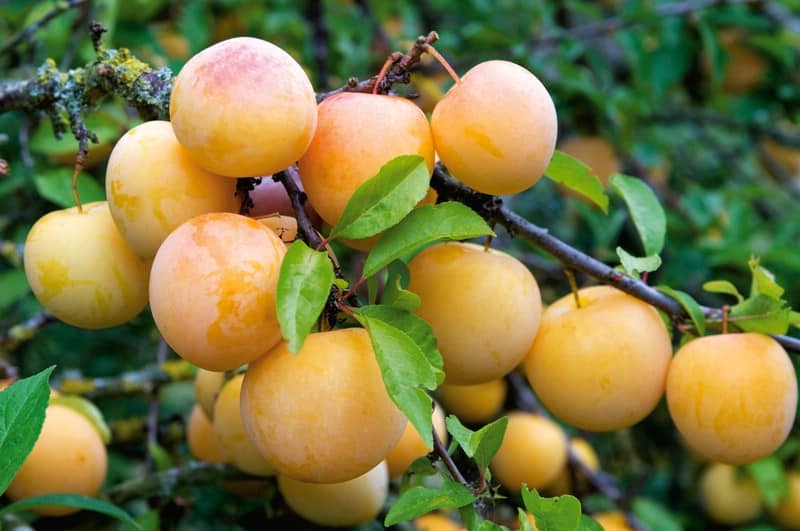

Compote
Plum Kompotnaya is suitable for growing in central Russia. Fruits weighing 30-45 g, regular oval shape. The plum is sweet and sour, juicy and aromatic, the skin is thin. The yield is high and stable. Ripe fruits are suitable for fresh consumption and for preparing preparations for the winter.
Self-fertile varieties
Self-fertile varieties are very rare in the group of plums with yellow fruits. Yet such exceptions do occur. If there is not enough space on the site for planting several plum trees, you should pay attention to these varieties, because they themselves, without pollinators, can give good yields.
- "Memory of Timiryazev" - a variety of plum that grows up to 3 meters. The crown is medium thickened, rounded. Flowers are white, lush, oval in shape, weighing up to 30 g. Productivity up to 35 kg / tree. The peel is yellow, with a red blush on the sunny side. There are dark spots under the skin. There is a thick bloom on the peel. The harvest ripens by the end of summer. The bone is easily separated from the pulp. The variety is considered universal, the fruits are eaten fresh, but you can also try a recipe for the winter of compote, jam or even a sauce like tkemali from this variety of plums.
- "Morning" - medium-sized variety. The crown is not very thickened, but formation is required. Fruiting begins 4 years after planting. The harvest ripens by mid-August. Each tree can be harvested up to 15 kg. The fruits are oval. There is a dense, white coating on the yellow-green peel. On the sunny side, blush is possible. Fruits are small, weighing 26-30 g. Sweet plums, spicy aroma. The main disadvantage is that the tree does not tolerate frost well.
Large-fruited
Large-fruited plum varieties are considered the most popular. This is not surprising, because every summer resident, growing fruit trees on his site, is trying to achieve maximum yield. And the larger the fruit grows, the better.
Gigantic
The main trunk belongs to the category of tall and grows within 4 m. Crohn's with abundant thickening. After planting, a young seedling bears fruit in the 3rd, sometimes 4th year. Productivity within 36-41 kg. Plums weighing 40 g. The skin is dense, the pulp is sweet and juicy.


Angelina
A hybrid called Angelina belongs to the tall category. The trunk can grow up to 3 m. Fruits are oval, large. Weight ranges from 113 g. The skin is dense and glossy. The pulp is juicy, it tastes sweet and sour. The seed is small in size, it is easily separated from the pulp.Angelina begins to bear fruit in the 2nd year after disembarkation.
The president
Plum President is prone to rapid growth. Anti-aging pruning will have to be done twice a year. The fruits are large, weighing from 50 to 100 g. The skin is dense, with a waxy coating. The pulp is sweet, easily separated from the stone. The tree is able to withstand frosts down to -25 degrees.


Starting
Plum Startovaya belongs to the winter-hardy, there is no need to cover the tree for the winter. It tolerates heat calmly, although additional watering may be required in case of prolonged drought. Plum begins to bear fruit early. Up to 55 kg of harvest is harvested from one tree. Plum Startovaya has a long shelf life, it is 3 weeks.
Reviews of yellow plums
Yellow plums are not as popular as blue, purple plums, and yet they are not uncommon in horticulture. Depending on the variety, gardeners love the yellow plum for certain qualities.
- Nina Zubova: “Yellow Afasskaya plum has been grown for many years. What I like most about her is the taste - sweet, juicy, versatile in terms of consumption. Jam or recipe for tkemali from it turns out to be excellent, sour, refreshing. I often make fruit salads in the summer. The tree takes a little time to care, you only need to follow simple norms, such as watering and daily feeding. He even rarely gets sick, during the entire cultivation period there were only a couple of serious problems, but fungicides quickly helped. "
- Ivan Makarenko: “I have been growing“ Memory of Timiryazev ”for more than 20 years. Plum feast for the eyes. The fruits are very tasty, they are quickly disassembled on the market. Plums are one to one, uniform, with a pleasant color. The stone separates relatively well, so there are no problems with canning. But, in general, it is not difficult to grow a tree, it rarely gets sick, it is resistant to severe frosts. "
- Lydia Gorbunova: “Of all the yellow plums, I like Coe's Golden Drop the most. I have been looking for this variety for a very long time, they brought it to me from abroad. This plum yields large yields, the fruits are sweet, they look beautiful on the tree. Part of the crop is used for conservation, the other part for sale. Recently I have been breeding this variety. In our region, the tree needs some care, but for a foreign species this is quite normal. "
How to plant plums outdoors
Plum prefers to grow in open, sunny areas. Or in partial shade, but the main thing is that the seedlings are in the sun for most of the day. It is not recommended to plant seedlings in the lowlands, where water accumulates in the spring. In such conditions, the tree will often suffer from fungal diseases.
Loamy or sandy loam soil is suitable for the culture. The optimum acidity is 6.5-7. If the acidity is higher, the soil needs to be deoxidized - add lime or dolomite flour.
Planting plums according to the technique is not much different from planting seedlings of most fruit trees. Annual seedlings are planted in early spring or mid-autumn. In a few weeks, the soil is dug up and complex mineral fertilizing is applied.
Planting process:
- Dig a hole 70-90 cm deep, up to 1 m wide.
- Drainage can be poured into the bottom.
- Place the seedling in the hole and bury it with soil.
- Near the trunk, the soil is compacted.
- Nearby, you can drive a stake and tie a tree to it for the first time, so that it does not sway during strong winds.
At the end of planting, pour abundantly with heated water.
If the planting was in the fall, the soil can still be mulched. This measure will prevent the roots from freezing in the seedlings that have not yet matured.
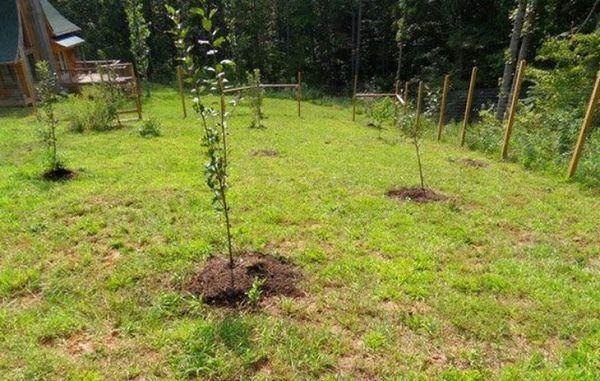

Review of popular varieties of yellow plums with photos and descriptions
Greetings, friends! Gardeners have been cultivating plum trees for a very long time. And they are still one of the most common fruit and berry plants. Special attention should be paid to yellow varieties of plums, which are gaining more and more popularity.Due to their taste and attractive appearance, they have won many fans. Let's consider separately some varieties of yellow photo plums with a description of their qualities, advantages and disadvantages.
Like other varieties of plums, yellow varieties can be large and small, late and early, sweet and sour. Any gardener will find a suitable variety for himself. All of them are united by the versatility of use - yellow plums can be eaten fresh or processed into jam, jam, compote.
Breeding history
Plum variety "Yellow Hopty" was bred in 1930 by the Russian breeder N. Tikhonov. The research was carried out in the city of Ussuriysk, in the garden of an amateur gardener Hopta.
Tikhonov did a lot for the practical cultivation of this fruit novelty in the Asian half of Russia. In subsequent years, this plum became one of the main varieties in horticultural farms in Siberia, the Urals and the Far East.
Already in 1974, "Yellow Hopty" was included in the state varietal register and officially zoned for the West Siberian and Ural regions.
In particular, for the Altai region with the participation "Yellow Hopty" were bred "Zarya Altai" and several other promising species, in Krasnoyarsk - the plum "Divnaya".
From "Yellow Hopty" its good adaptability to local climatic conditions, good yield is transferred to new varieties. At the same time, her offspring can receive from the “parent” a distinct bitterness of her skin.
Altai Jubilee
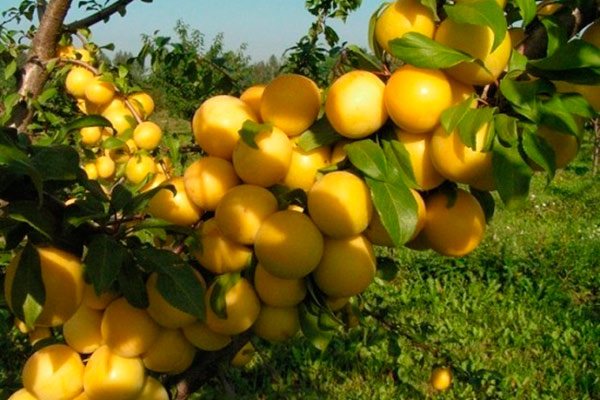

This variety is the most common of all and is suitable for many regions. Feels great in the conditions of Western and Eastern Siberia, the Urals and Northern Kazakhstan. This plum was bred by crossing two varieties of excellent quality: Manchurian Prune and Immunnaya.
Produces medium-sized, about 15 grams, round-shaped fruits. Their distinctive feature is their color, the rich yellow color of the skin is covered with a reddish blush. On top of it, there is a whitish waxy coating.
Plum pulp has a yellow-orange color, loose structure, very juicy and soft. The taste of the fruit is rich, slightly sour, which is set off by a sweet aroma. The stone in a ripe plum is large enough and easily separated from the pulp.
The tree itself does not grow very tall, has a rounded crown and not too many branches. With proper care, the plant begins to bear fruit three or four years after planting in a permanent place. The variety also has a higher yield. It is also worth noting the excellent frost resistance of the Altai Yubileinaya plum.
What varieties of plums are best for the Moscow region and the middle lane
Finding the best plum varieties for the regions of the Moscow region and the middle lane is not as difficult as, for example, for the northern latitudes. Most varieties of culture survive freezing temperatures in this climate.
Yakhontova
Plum Yakhontovaya refers to tall. The tree can reach a height of 5-6 m. The crown is compact, wide. The fruits are round in shape, the rind is dense with a waxy bloom. The pulp is juicy, the seed is simply separated. The weight of the fruit is 35-45 g. The taste of plums is sweet with sourness. The tasting score is maximum and is 5 points out of 5.
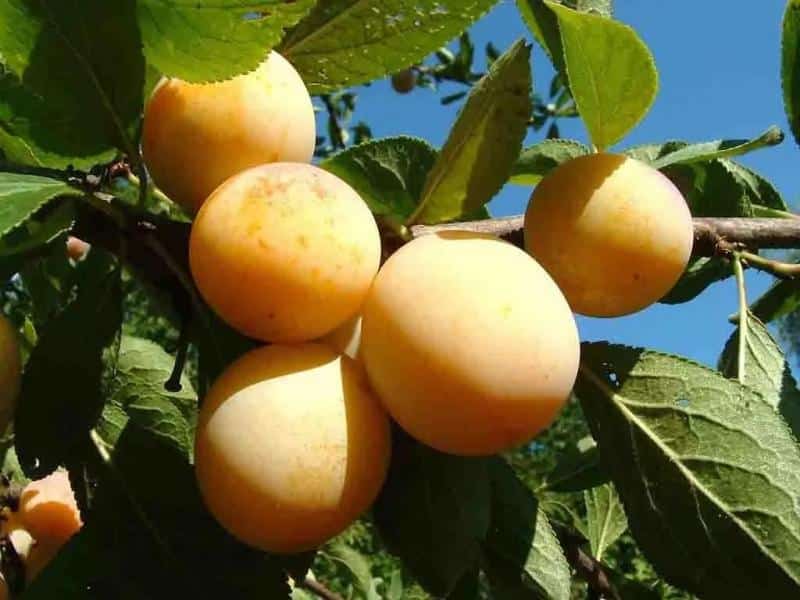

Russian plum
Russian plum belongs to the early ripening varieties. The yield of the tree is high and is about 45 kg. The harvested fruits, if they have not reached biological maturity, are capable of ripening. Fruits are large, weighing up to 55 g. Fruits are sweet and sour, the pulp is juicy. Skin with a white waxy coating. The downside of the Russian plum is its rapid growth. After 2-3 years, you have to carry out anti-aging pruning.
Gold of the Scythians
Scythian gold is not a plum variety, but a type of cherry plum. But cherry plum in taste and appearance is very similar to plum, since it is a kind of home culture.Scythian gold belongs to medium-sized, trees rarely grow more than 2 m. Abundant flowering, large fruits, weight is 40-55 g. A small seam can be seen on the skin. The skin is dense, covered with a white waxy coating.
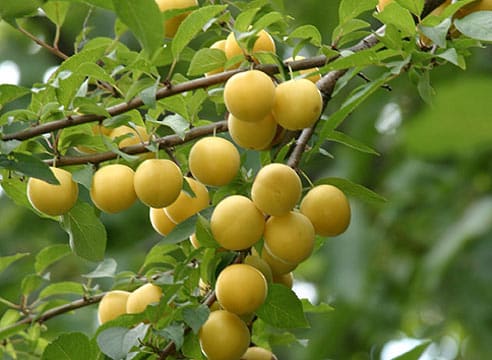

Hungarian Bogatyrskaya
Hungarian Bogatyrskaya is a medium-sized, not thickened tree. Inflorescences are collected from 2-3 flowers. Ripe elliptical plums, weighing 40 g. Maximum weight - 60 g. The skin is thick, with a thin waxy coating. The stone is small, practically does not separate from the pulp. The pulp is dense, greenish with a honey flavor.
Hungarian Bogatyrskaya belongs to frost-resistant varieties. But it is hard to tolerate prolonged overdrying of the earth.
Traveler
The fruits of the Traveler plum reach a mass of 20-35 g. The side seam is poorly expressed. Waxy skin. The pulp is bright orange, soft, juicy. It is difficult to separate the skin from the pulp. Traveler is a pollinating plum for some other species. The advantage of the variety is resistance to severe frosts. Drought tolerance at an average level.
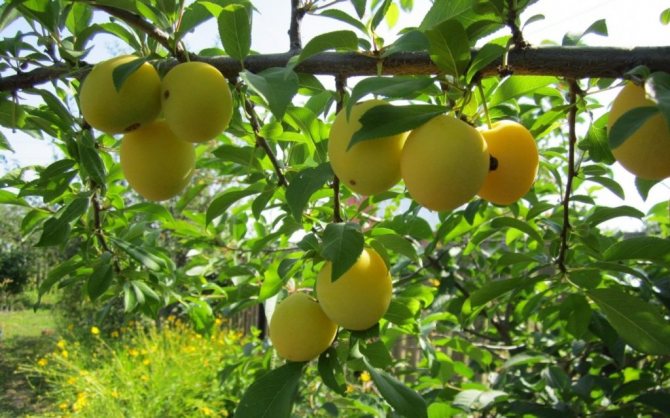

Honey (White Honey)


In terms of taste, this is one of the best varieties of yellow plums, reminiscent of real honey. This species is of Ukrainian origin, but it is even adapted to the harsh climate of some northern regions.
It produces large fruits, on average 30 grams, and some specimens reach a weight of 50 grams. The plum has a regular round shape, a beautiful bright yellow hue; there is a whitish waxy coating on the surface of the skin. Thanks to its dense skin, this variety can be easily transported with minimal risk of damage to the fruit. The pulp is juicy, rich in color, quite dense. The bone is difficult to separate.
The honey plum is one of the earliest in terms of ripening. The fruits can be harvested at the beginning of August. The variety needs pollinators, so the appropriate trees should be planted nearby. Vengerka Rannyaya and Renklod Karbysheva are perfect for these purposes.
The tree usually grows quite large, and with proper care and favorable conditions, it can reach five meters in height. The crown is rounded, there are not very many main branches. The plant is frost-resistant and even the most severe frosts do not harm it. This variety does not need additional care, the main thing is to provide proper conditions. Some gardeners hesitate to plant the honey plum due to the fact that the plant is large and occupies a large area on which two other high-yielding trees can freely accommodate.
Characteristics of early maturing species
It is important to study the description of the yellow-fruited plum due to the fact that there are several main varieties in terms of ripening. Early plum ripens in early summer, but after harvesting it is not stored for a long time.
Yellow Ball
A characteristic feature of the Yellow Shar hybrid is the taste of the fruit. They resemble a mixture of peach and pineapple. The fruits are small. From a distance, the tree can resemble sea buckthorn. The variety is frost-resistant, able to withstand frosts down to -50 degrees. The tree bears fruit in the third year after planting a seedling.


Altai Jubilee
The average weight of the fruit is 15 g. The fruits are elongated and oval. Unlike other varieties, Altai Yubileinaya has a richer skin tone. The skin is covered with a waxy coating. Ripe fragrant fruits.
Yantarnaya Mlievskaya
Large-fruited variety, fruits on average are up to 70 g. Fruits are of the correct rounded shape. The pulp tastes sweet with a grape flavor. The skin is thin, therefore, after harvesting, the fruits are not stored for a long time. The yield is about 55 kg.
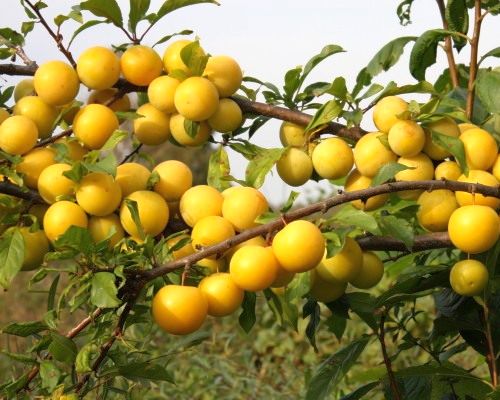

Honey
The honey hybrid tastes like flower honey, which distinguishes it from other yellow-fruited varieties. It can be noted that the fruit has a slight sour taste. Fruits are large, average weight is 30-50 g, round shape. The skin is thin, but dense with a waxy coating.
Golden Large
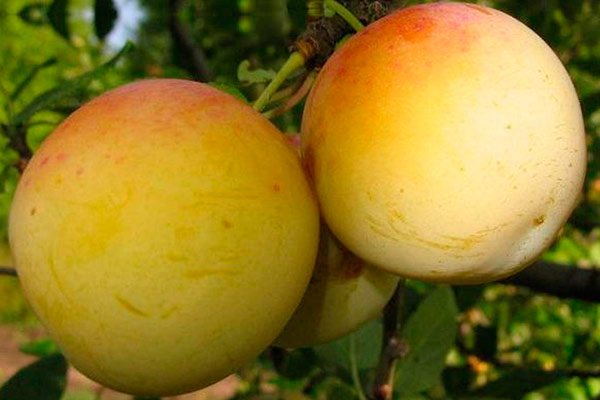

This variety of plum has also proven itself in all respects. The fruits are large, weighing on average 43 grams, with a yellow tint with small pinkish spots. The skin is not too dense, it easily leaves the pulp. The plum is oval in shape, with small depressions at the funnel and at the top. The pulp is also yellow, soft and rich in juice.
Belongs to late-ripening varieties, fruits ripen only in autumn, at the beginning of October.
The tree is of medium height, pyramidal in shape, there are few main branches, which excludes excessive thickening. Mainly bouquet branches bear fruit.
The variety is distinguished by its increased yield, from each plant, on average, you can get 27 kilograms per season. For the plum to start bearing fruit, at least 4 years must pass after planting.
This variety has a lot of serious advantages:
- high frost resistance;
- drought resistance;
- immunity to pests and various diseases;
- long shelf life.


It has rounded large (about 26 grams) fruits of a yellow-green hue, in the sun they acquire a pinkish tone. The pulp of the plums is yellow, sweet and sour in taste, medium soft.
The tree is not very tall, with an oval crown. Mainly bouquet branches bear fruit. The variety is self-fertile, does not require planting a number of pollinating plants. The first crop can be harvested 6 years after planting. Perfect for the Moscow region and the Central region, but due to low frost resistance it does not survive in Siberia.
Yellow varieties of Russian plum
Yellow plums bring color variety to your fruit basket. They are in no way inferior to their violet-blue counterparts, and sometimes even surpass them in terms of commercial characteristics.
Memory of Timiryazev
The variety is distinguished by beautiful medium-sized oval fruits weighing 20–25 g. Taste - sweet and sour, freshish.
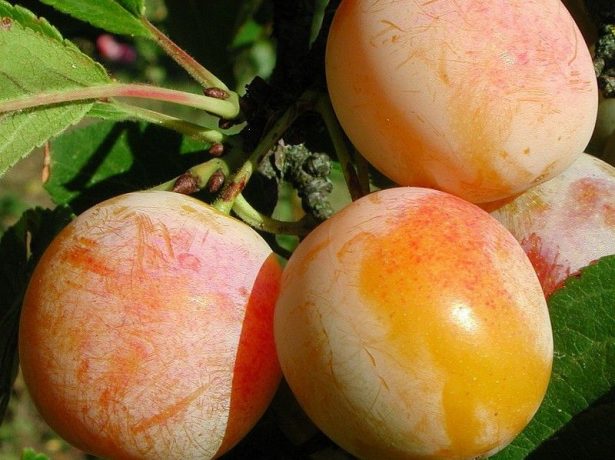

Plums in Memory of Timiryazev are well stored and tolerate transportation
- in season, the tree gives up to 30 kg of plums;
- does not really like frost and drought, but quickly regenerates;
- self-pollinated;
- early maturity - 3 years;
- the harvest ripens in early autumn.
This variety is not afraid of clasterosporia and fruit rot, but it can be severely damaged by a tick.
Kolkhoz renklode
Kolkhoz renklode is an old proven variety. The taste is sweet, slightly sour. Medium plums weighing up to 20 g.


The skin of the plums is thin, dull, with numerous subcutaneous dots of gray color, well separated from the pulp
- amicable ripening in the 20th of August;
- self-infertile;
- early maturity is not very happy - the first fruits appear after 4 years;
- perfectly tolerates frosty winters;
- the older the tree, the higher the yield - mature yields an average of 39 kg.
Susceptible to fungal diseases. If the crop is not harvested in time, overripe fruits crumble.
Honey white
The variety is suitable for intensive gardening due to its large yields. Honey white tree difficult to grow in a small area due to the very spreading crown. Appetizing yellow fruits weighing up to 55 g are famous for their interesting honey taste, highly appreciated during tasting - 4.5 points.
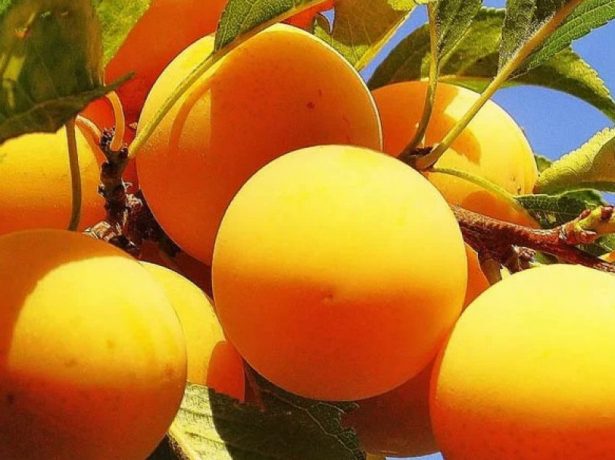

Despite its large size, the tree does not experience thickening and does not need constant pruning.
- the first plums can be enjoyed at the end of July;
- tolerates cold and drought well;
- gives up to 35 kg per tree;
- not afraid of transportation and can be stored for up to 60 days:
Possesses low resistance to diseases, suffers from pests.
Tatar yellow
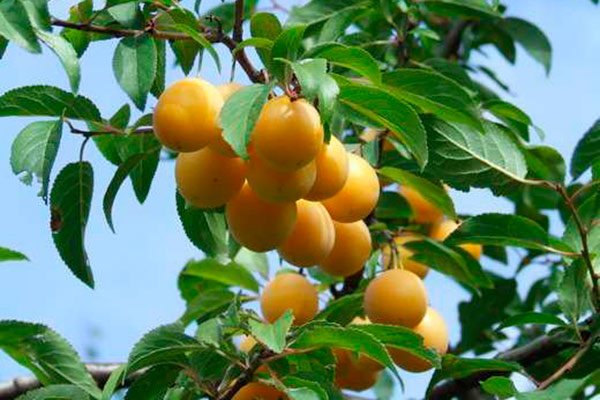

The variety has excellent taste and versatility. Can be eaten fresh and processed into jams or preserves. The plums are not very large, weighing about 15 grams. The fruits are bright yellow in color with a honey tint; there is a slight whitish bloom on the surface of the thin skin.
The trees are of medium height, with a spreading oval crown.Branches of medium density, brown in color with dark green rounded matte leaves. To obtain a harvest, pollinators are needed, the fruits ripen around mid-August.
It also has an average frost resistance, so it is not suitable for cultivation in the harsh conditions of Siberia. This species is grown in the Central region, Moscow region and southern regions. The most significant disadvantage is susceptibility to disease and pest attacks.
The sweetest plums
Sweet varieties of plums are good as a dessert fresh and in sweet preparations. They are considered the best for drying.
Hungarian Korneevskaya
The most delicious prunes are obtained from Hungarian Korneevskaya. Fresh plum is sweet, without a hint of sourness, weight - 31 g.
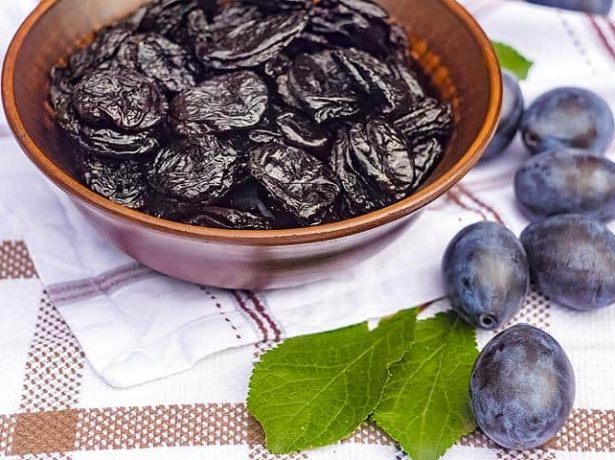

With a bountiful harvest, tree branches can break
- does not bear fruit for the first 4 years;
- self-pollinated;
- collection from a tree - up to 30 kg;
- tolerates moderate frost and drought, is not damaged by pests and diseases;
- ripening time - end of August.
Yakhontova
Plum Yakhontovaya - juicy and sweet with a thin skin and a beautiful bright yellow color. Size - medium, weight - 30 g.


Plum Yakhontovaya received the highest tasting mark - 5 points
- partial self-fertility;
- collection from a tree up to 50-70 kg;
- tolerates winter well;
- does not get sick and is not affected by pests;
- ripens in August.
Early Loshitskaya
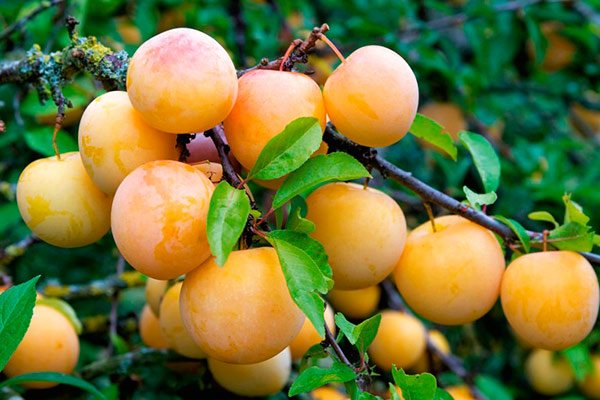

The fruits are sweet, with a slight sourness and honey aroma. The color of the plums is yellow-green, sometimes a slight blush appears. The pulp is very juicy and is easily freed from the stone. The variety is distinguished by late flowering, but a rich early harvest. One tree can produce up to 30 kilograms of plums. The first crop can be harvested 4 years after planting the seedlings.
The crown of the tree is triangular, the plant tolerates frost perfectly and thanks to this it can be grown in Siberia. Pollination requires planting nearby other varieties.
The best vigorous plum varieties
We bring to your attention the best varieties of plums that can easily take root in the northern regions of Russia.
Smolinka
The fruit is medium, dense, has a sweet and sour taste. The pulp is elastic. The berry is regular, egg-shaped without pronounced depressions, the abdominal suture is practically not noticeable. It is considered one of the best varieties of plum for central Russia, so it gets along quite well in the Moscow region.


Early subspecies, good fruiting. Harvesting takes place in the third decade of August, and up to 23 kg can be removed from one tree. The weight of one fruit ranges from 30-40 g. Great for drying and curing. Smolinka makes a wonderful oily prune.
- tallness - over 5 meters;
- begins to bear fruit in the second year;
- with persistent frosts, it can freeze slightly, while with the onset of cold weather it quickly recovers;
- amenable to grafting;
- a voluminous deciduous system that takes up a lot of space in the garden, lends itself to pruning without harming the sap flow.
Zarechnaya early
The fruit is large, oval, dark purple in color. The weight of one plum can reach 55 g. Thanks to the unimpeded removal of the stone, the berries are easily suitable for all kinds of preservation, as well as for drying and drying.
- frost-resistant species;
- increased productivity;
- the beginning of fruiting - the second year after planting the seedling;
- dessert, sweet and sour taste.
After 3-4 years of growth, it gives many stepchildren, which greatly weaken the plant. It is necessary to get rid of them in a timely manner, to prevent thickening of the tree and "wildness" of berries. It is recommended to carefully cut down the stepsons so as not to damage the trunk of the main tree. It is forbidden to use chemicals. They are used exclusively to combat dense thickets.
Early
Another variety of fruit plant, which is distinguished by high yields and increased fruit weight. The mass of one plum reaches 45 grams, the taste is sweet with a slight sourness. Fruit ovary occurs in the second year of seedling cultivation.


The tree is tall, in five years it can reach 4.5 meters.
Traveler
The best plum variety for the Urals and its regions. This is due to its high frost resistance. The fruit is large, round and incredibly tasty, has a yellow color with a purple tint. The bone is small, easy to get.
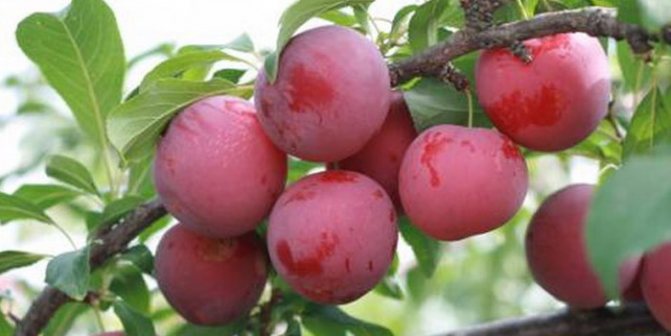

Begins to bear fruit in the first decade of August, gives a high yield - up to 25 kg.
Blue bird
Mid-season, zoned for cultivation in a northern climate, so the middle zone of Russia is excellent for planting this crop. Mid-early subspecies, the berries of which are dark blue and quite heavy - up to 50 g.
The berries are oval, dense and waxy bloom. The crop can be harvested in the second decade of August. The stone separates well from the pulp, so from this culture you can either close the jam or dry, dry and pickle. The beginning of fruiting occurs in the second year. The disadvantage is an enlarged, spreading crown, which has a spherical shape.
But as for the benefits, the most significant ones include:
- despite the spreading of the crown, the internal branches do not block the light from each other, and ripening occurs evenly;
- seedlings are not afraid of frost;
- resistant to the most common diseases of fruit crops: minoliosis, polystygmosis and clotteroporosis;
- if the planting of the seedling and care were carried out at the proper level, then up to 35 kg can be removed from one tree;
- self-fertile.
And this, in turn, allows us to classify the Blue Bird as one of the best plum varieties for the Vladimir and Leningrad regions.
Often, the famous Georgian sauce Tkemali is made from these berries in Russia (in Georgia it is made exclusively from Tkemali plum-cherry plum). A very tasty addition to meat dishes, side dishes, vegetables and grilled poultry.
VIDEO: How to make Tkemali sauce at home. Georgian cuisine
Yakhontova
A late variety of a fruit plant that will easily survive spring frosts without harming the ovaries. For several years it can grow up to five meters. The berries are characterized by a bright yellow color, sweet and sour aftertaste. Average size - up to 35 grams.
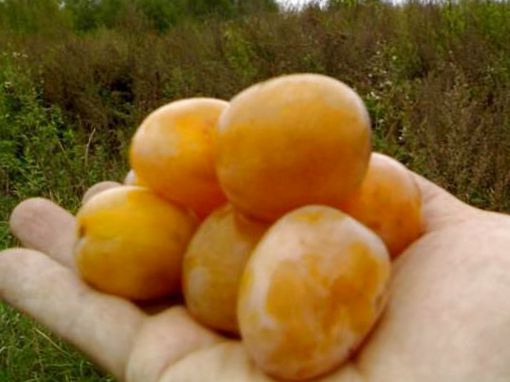

The yield is high - up to 55 kg in one season. Fruiting occurs in the summer - the third decade of August. In addition, it is worth noting an important feature of Yakhontovka - it calmly tolerates dry weather and various fungi.
In fairness, it must be said that the fruits of this culture are extremely poorly stored, therefore, immediately after harvest, they should be processed immediately.
To make the berries large, you need to monitor the number of ovaries. The more there are, the smaller the fruit.
Egg blue
The berries are fragrant, dark red in color, while the flesh is yellow. Fruiting occurs at the end of August, and ends in mid-October, so you can eat plenty of this fruit and preserve it. The mass of one berry does not exceed 30 g. It is not afraid of frost.
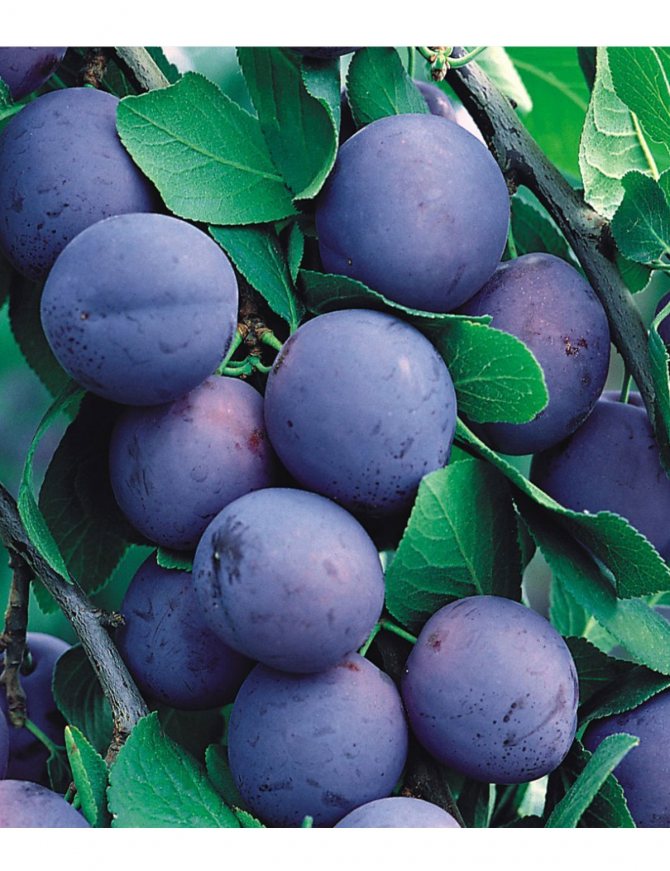

The main condition is to ensure good maintenance and regular fertilization of the soil. This will allow every year, starting from the second after planting, to collect rich crops.
The best medium-sized plum varieties
If you are picking a tree for your home garden, then you can choose something from medium-sized plants that differ not only in their small dimensions, but also in the excellent taste of the fruits.
In memory of Timiryazev
Recognized as one of the best plum varieties for the Moscow region and adjacent regions. Harvesting takes place in the first half of August. The berries are round with an inherent yellow color and a characteristic red "cheek" for this species, without a visible abdominal seam.
Juicy, dense fruits have a sweet taste with a slight sourish tinge. One adult seedling (from four years old) can be harvested up to 35 kg per season. The plant is water-loving, in need of preparation for the winter season.
Dasha
Possesses high frost resistance.The berries are oblong, red with sun-colored flesh. The taste is sweet and sour, but at the same time the acid does not overpower the sweetness.
Ural variety "Dashenka"
The species is fast-growing, capable of bearing fruit in the second year of its growth. Pollinator - nearby trees (cherry, sweet cherry, etc.), insects.
Hungarian Korneevskaya
They are distinguished by high productivity, but at the same time, the first fruiting occurs only in the sixth year of growth. The fruit is brown-purple, medium-large, and up to 55 kg can be removed in one season.
Hungarian Korneevskaya (Italian)
Ochakovskaya yellow
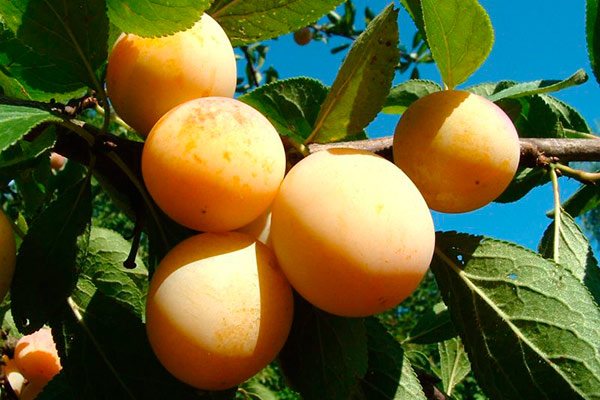

This variety has a long history and has been grown in Russia for a very long time.
The fruits are oval in shape, medium in size, reaching a weight of 30 grams. Their color ranges from light green to deep yellow. They have a very juicy and soft pulp.
One of the most productive varieties, with proper care and favorable conditions, up to 80 kilograms of plums can be harvested from one tree. Flowering is late enough and the fruit ripens by the end of August. It is necessary to plant pollinating trees nearby, the most suitable varieties for this are Renklode Ulena and Renklode Zeleny.
Frost resistance is weak, so this variety is best suited for warm climates, in the Moscow region it does not ripen.
"Egg yellow"
A kind of late-ripening not common variety. The tree grows tall with a sparse crown.
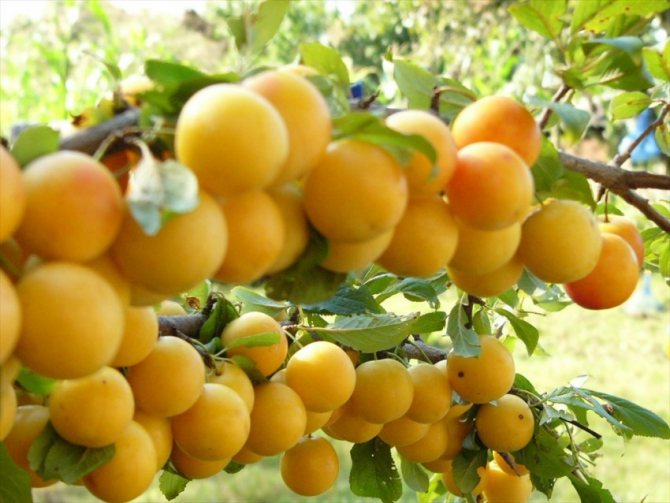

Large, oval, asymmetrical. This type of plum is perishable (up to 8 days old). The surface is glossy, light orange dotted. The stone separates very poorly from the sour pulp.
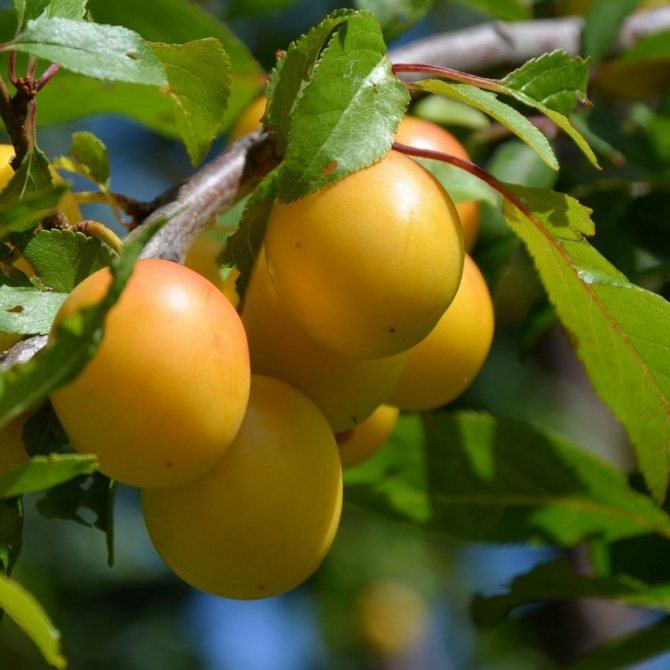

Columnar varieties
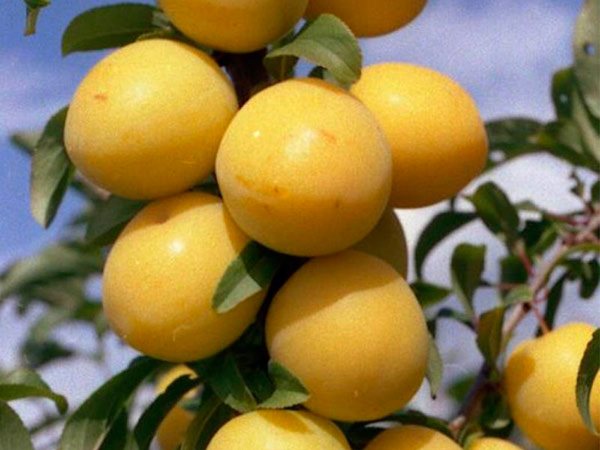

Such varieties of plums appeared relatively recently, but managed to gain considerable popularity among gardeners. It is quite easy to care for them, the trees take up little space on the site and at the same time give a rich harvest for many years, which, moreover, is easy to harvest. Abundant fruiting begins in the third year after planting of seedlings.
Columnar plums do not need pruning, as they have no side branches, only short spears extending from the central trunk. It is on them that the fruits are formed.
Currently, one species of yellow columnar plum has been bred - Mirabella. Differs in late ripening, the yield can reach 12 kilograms from one tree. Fruits are medium in size, bright yellow with a pale bloom. Plums are best for processing into jams, preserves and compotes.
The variety of all kinds allows you to choose the right plants for any garden. And if you share this article with your subscribers, I assure you, they will thank you very much for such useful information.
Self-fertile
Self-fertile varieties, in comparison with others, have a significant advantage. There is no need to plant a pollinator next to such a plant.
Golden ball
It is considered a variety with an early maturity of the crop. Belongs to the self-fertile category. The first ripe fruits appear on the tree in July. The fruit has a sugar flavor that is similar to a peach. Weight ranges from 37 to 51 g. About 77 kg are harvested from one tree.


Golden large
Plum Golden large refers to winter-hardy and drought-resistant varieties. In addition, the plum is highly resistant to disease. The yield is late, the first fruiting begins in the 5th year after planting. Up to 27 kg of harvest is harvested from one tree.
Covenant
The height of the tree is about 4 m, the plant bears fruit in the 4th year after planting. Flowering, like fruiting, is late. The weight of ripe plums is about 40 g. Due to the sun, the skin tone turns from yellow to pinkish. Ripening begins in the second half of August. The skin is slightly waxy.
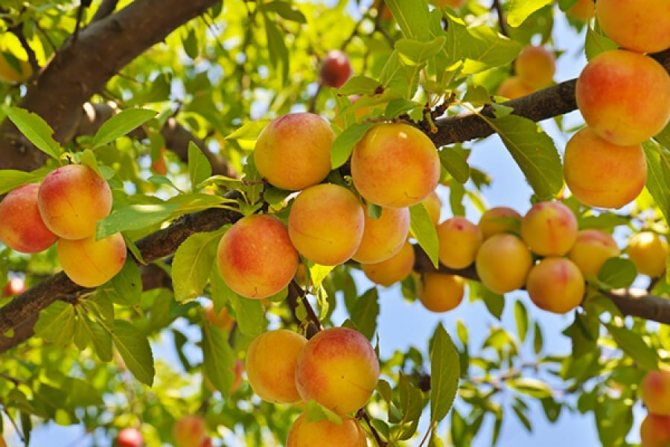

Honey white
This variety is resistant to severe frosts. Fruit ripening occurs in the last days of July - early August.The average weight of fruits is from 40 to 55 g. 43 kg of harvest is harvested from one adult tree. When fully ripe, the peel takes on an orange tint.
Yellow plum
The large and beautiful yellow plum is appreciated for its sweet, slightly sour taste. The main difference is, of course, a beautiful amber or golden hue. As for agricultural technology, there is one important nuance. Most of the varieties and hybrids are the result of many years of breeding work, when wild forms and cherry plums were crossed. As a result, this made it possible to achieve a delicate sweet taste with sourness due to the high content of ascorbic acid, resistance to frost or drought, and other unfavorable conditions. But precisely because of their origin, many of them cannot pollinate on their own.
Late varieties
Late varieties of plums are best grown in the southern regions of the middle lane, where they have time to ripen before the onset of the first cold weather.
Svetlana
Variety Svetlana - Primorsky selection. Medium sized plum (up to 20.5 g) with a good sweet and sour taste. The skin is tough, poorly cleaned.
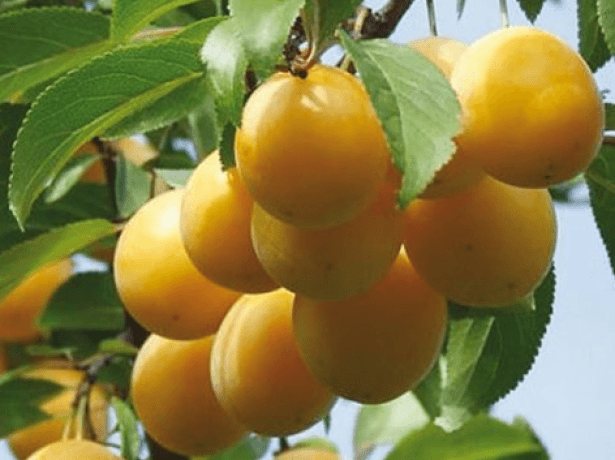

The main advantages of the variety can be considered indicators of winter hardiness and productivity.
- winter hardy;
- the harvest ripens from late August to mid-September;
- well transported;
- harvest from a ten-year tree - up to 30 kg.
More or less resistant to diseases (except for moniliosis), not prone to gum flow, but there is a likelihood of damage to the fruit by the moth.
Anna Shpet
Anna Shpet is thermophilic, she is more suited to the climate of the south of the middle zone. Dessert fruits are large (40-50 g) and have an excellent taste - delicate and sweet with a slight sourness.
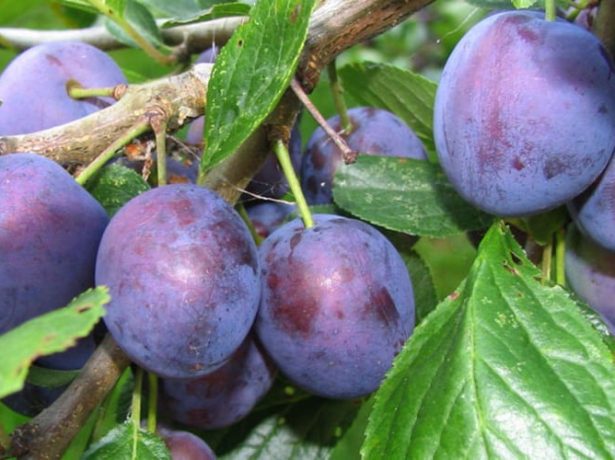

Anna Shpet's frost resistance is average, but the tree quickly recovers and tightens frost holes
Characteristics of the Anna Shpet variety:
- bears fruit only 4–5 years after planting;
- regenerates well after frost, tolerates drought normally;
- very late variety - the harvest ripens at the end of September;
- partially self-pollinated;
- an average of 30 kg is collected from a tree.
Possible infection with polystygmosis and moniliosis.
Bolkhovchanka
Bolkhovchanka is a universal variety; it bears fruit with a large juicy plum weighing up to 34 g. It has a good sweet, slightly sour taste.
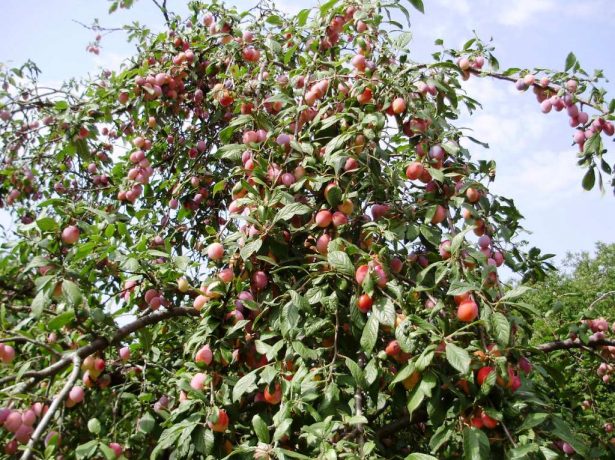

Outwardly, the Bolkhovchanka plum is not very attractive, but the taste is estimated at 4.2 points
- not self-pollinated;
- high-yielding;
- fruits can be stored and transported without compromising quality;
- kidneys are not frozen.
The variety is immune to clasterosporium disease, but it is susceptible to infection with fruit rot. Aphids bypass him.
Features of varieties of yellow plum
There are many varieties of this culture and almost every year breeders breed new hybrids. They can be divided into several groups. So, there are self-fertile varieties. They produce crops on their own, they don't need pollinators. However, with all the advantages in terms of yield, they are inferior to self-fertile varieties. On the latter, fruits are formed only if other plum crops grow nearby, which serve as a pollinator. Therefore, it is important that such trees grow on the site that will bloom at the same time as self-fertile crops.
Important! When choosing the appropriate option, parameters such as frost resistance, yield, fruit characteristics, etc. should be analyzed.
For example, gardeners are often interested in the cultivar of a small round golden plum. It could be Altai anniversary, Morning or Tatar yellow. But of the listed options, only the first is universal, the rest have less frost resistance.
One of the best table varieties is plum. Sunrise yellowderived from Renclaude. These are fruits of a greenish-yellow color with raspberry blotches, covered with a bluish bloom. Characteristics of this variety:
- high yield: on average, a six-year-old tree bears 49-50 kg of fruit.Moreover, it begins to bear fruit at 4 years old, sometimes at 5 years. These fruits (and from a biological point of view, drupes) with a fairly dense skin and a small and well-separated stone appear in August. They are large, weighing up to 42-45 g;
- excellent taste: the pulp is juicy, sweet and sour;
- frost resistance.
Plum hopt cannot boast of such large fruits. It brings light weight up to 20 g. But on the other hand, these plums have a pleasant sweet and sour taste. Their skin is thin, greenish-yellow in color. The stone is large, easily separated from the pulp. The yellow plum of the Hopta variety is a so-called self-fertile crop. This means that it must fertilize at the expense of other plum trees. For these purposes, a variety with the same flowering period as that of Hopta is suitable. Among its positive characteristics are:
- excellent taste;
- the possibility of obtaining the first harvest in 3-4 years after planting the tree;
- good yield: up to 20 kg per tree;
- relatively high frost resistance, although the buds that appeared in May do not tolerate frost well.
Plum Mountain yellow - mid-season variety. Ripens in the second half of August. The fruits are beautiful, large (24-25 g, but sometimes more), the pulp is sweet. The skin tone of the fruit is light yellow. Among the characteristics of the Mountain yellow plum are the following:
- high winter hardiness, due to which it is suitable for growing in the Urals and in the Altai Territory;
- high yield (plum is also considered self-fertile, but with a pollinator it can produce up to 40 kg per tree).
Note! Small plum Altai Jubilee in itself is considered an excellent pollinator. It can be grown alongside the varieties described above. Its fruits are small, rarely weigh more than 16 g, but they have a very pleasant taste. The color is yellow, and on the sunny side it is reddish with a noticeable waxy bloom. The yield, although high, is irregular.
Plum has good performance Amber Mlievskaya... This variety was bred in Ukraine, suitable for the southern regions, since it is thermophilic. It is a self-fertile crop and needs a good pollinator. But if it is, then you can get a very high yield. It is considered a large-fruited variety, and these fruits are juicy, bright yellow, really amber. The weight of one piece can be up to 70 g. Its features also include:
- very sweet taste with a barely noticeable grape flavor. This type is considered by many to be the best for making jam, since ripe fruits contain a lot of pectin;
- good winter hardiness (it may not endure severe frosts, but moderate cold weather will not harm);
- early maturity, since the first fruits on such a tree appear already 2 years after planting;
- high yield: 1 adult tree is capable of producing up to 50 kg of plums.
In addition, it shows good indicators of drought tolerance. Another variety has a similar advantage - plum honey yellow (popularly referred to as Honey White). It was bred in the Donetsk region, and therefore the breeders were faced with the task of developing a drought-resistant species. In Russia, it is grown in the Central Black Earth Region. Practice shows that Honey can be grown to the north, but this requires the correct frost-resistant stock. Then it can be planted both in the Moscow region and in the north-western regions.
This is an early variety, the fruits appear in July. The tree belongs to the self-fertile category, it needs good pollinators. Of the positive qualities of Honey Yellow, large fruits can be distinguished - up to 50 g in weight and high yield (40-80 kg per tree, depending on the growing area).
Plum Mountain yellow
Plum is also a thermophilic variety. Golden large... It is grown mainly in the Lower Volga region, since it does not tolerate frost well. The main difference between the variety is its partial self-fertility.The harvest is relatively small: the maximum is 30 kg per tree. But the fruit has a pleasant sweet and sour taste, a beautiful light yellow tint and a fairly dense skin. They can even be left in the refrigerator to ripen. The shelf life is 1.5 months.
The most frost-resistant is Canadian plum... It differs from European varieties in the number of chromosomes. It is a species bred to grow in harsh conditions. Trees can withstand frosts down to -50 ° C. It blooms in May, but later than other plums, so the buds are not afraid of frost. Belongs to the category of self-fertile plants.
Important! Several different varieties of this species have been bred, which may differ in yield.
There is another very interesting variety - plum egg yellow... Basically, it is valuable as a rarity. The variety was first described in 1676, that is, it is one of the oldest. Its fruits are large enough, the yield is high - up to 40 kg per tree. But this variety is more interesting for collectors and enthusiasts, since the taste of the fruit is sour, the stone is poorly separated, the bright yellow skin is thin, and when fresh, these fruits simply cannot be stored for a long time. But this tree is resistant to both frost and drought. Begins to bear fruit only 6-7 years after planting. And you can use the fruits for making marshmallows and compotes.
For your information! Plum Yellow self-fertile is a universal option. It is a sprawling tree that bears fruit for 3 years after planting. The crop can be harvested in August. It is a frost and drought tolerant variety.
Late ripening
The advantage of late-ripening varieties is that after harvesting, the fruits are stored for some time. But they are often inferior in taste to the early and mid-early representatives.
Golden large
Large-fruited late hybrid, fruit weight is 40-50 g. The skin is pink-yellow, dense, slightly pubescent with a slight waxy bloom. The first fruits ripen in early September. Plum Golden large belongs to partially self-fertile varieties. The yield is average, up to 30 kg are harvested from one tree. The large golden one is winter-hardy, the tree tolerates frosts down to -35 degrees. In addition, the variety is resistant to drought and disease.
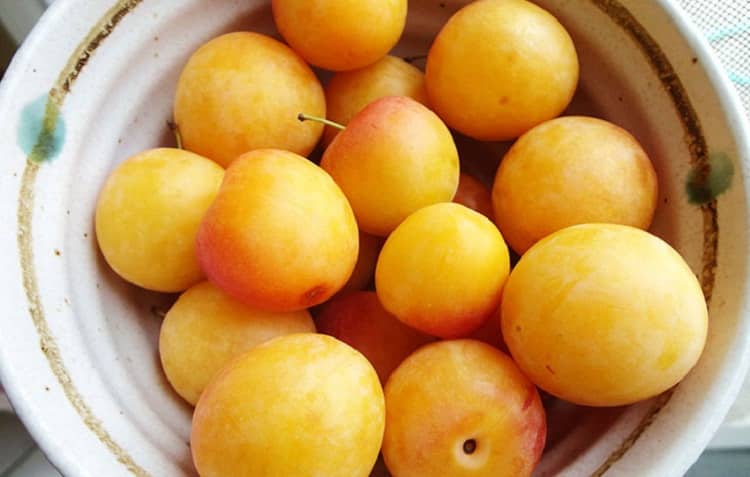

Yellow Afasca
The fruits of the Yellow Afasca plum ripen in the second decade of August. Fruit ripening completely takes place in September. The tree is medium-sized. Fruits are large, weight is from 45 g. The skin is dense, with a waxy coating. The stone is difficult to separate from the pulp.
The pulp is juicy and sweet to taste, with a sour taste. The tree is winter-hardy, rarely suffers from fungal diseases.
Egg yellow
Egg yellow is considered one of the most ancient and rare varieties. This species is endowed with a large number of disadvantages and is grown mainly by collectors, and not by summer residents for harvesting. The fruits are large, sour to the taste. Fruit is not stored for a long time after harvest. Plum is suitable for preparing compotes and pastilles.


Svetlana
The advantage of the Svetlana variety is that there is no need to cut the crown every year. The hybrid is self-fertile; pollinating trees will have to be planted nearby. Fruit ripening continues until the last days of September. Fruiting begins in the 5th year after planting the seedling. On average, the weight of the fruit is 25 g. The seeds are difficult to separate, the pulp is sugar with a sour taste.
Renklode Michurinsky
The maximum weight of Renklod Michurinsky plums is 35 g. The pulp is orange in color, juicy and sweet with a slight sourness. The stone separates well from the pulp. The variety is fruitful, winter hardiness at an altitude, annual fruiting. The crown is of medium thickening, the tree is fast-growing.
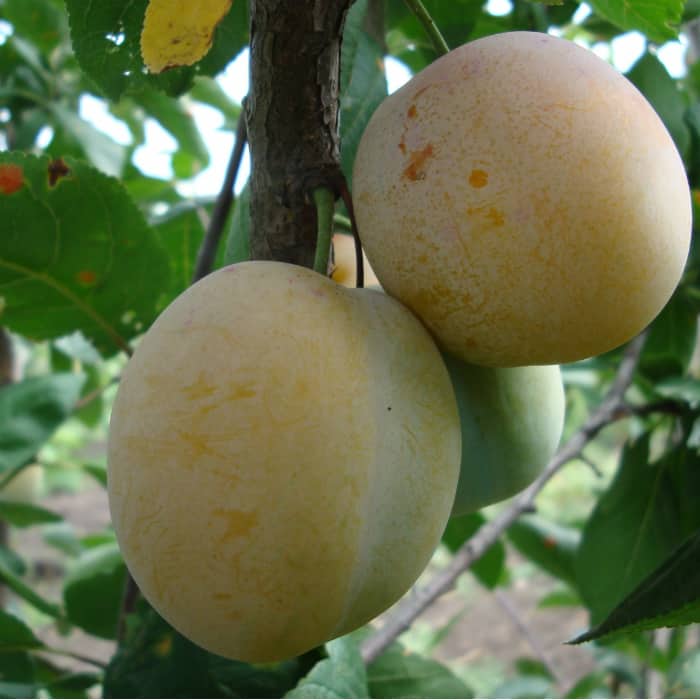

Hopt
Light yellow fruit. There is a whitish coating of wax on the skin. Small-fruited plums, weight is 15-20 g. There is a noticeable seam on the side of the skin.The skin is thinner than that of other varieties, the pulp is juicy, sweetish, sometimes there is a sour taste. The seed is large, it can be easily separated from the pulp. The Hopty plum belongs to self-infertile hybrids. Fruiting begins 2-3 years after planting the seedling.
See also
How to plant, grow and care for cherry plum, variety selectionRead
Mountain
Plum Mountain is a high-yielding variety that can withstand severe frosts. The crown is round, not thickened, the tree is medium-sized. The fruits are large, the mass ranges from 28 to 47 g. The pulp is yellow, the shape of the plums is round. The flesh is sugary with a sour taste. The seed does not separate well from the pulp. The harvest ripens in the second decade of August, the last fruits ripen in early September. The fruits are versatile in use.


Features of agricultural technology
The rules for caring for this crop largely depend on which variety the gardener is dealing with in this case. But there are rules common to all varieties.
So, it is theoretically possible to plant a plum in spring or autumn. In the conditions of Central Russia there is always a risk that the seedlings will not have time to take root during the autumn planting, and then they will simply freeze in winter. Therefore, it is still recommended to do this in the spring, in advance, 2 weeks before planting, having prepared pits with a depth of about 60 cm.It is not necessary to plant deeper, otherwise the bark of the tree will resist, its growth will be suppressed and the yield will decrease. The soil, which is removed from these recesses, is mixed with humus and again poured into the pit. At the same time, the seedling is tied to a wooden peg hammered alongside.
Important! Plum does not require complex care. In the first year, you need to prune, following a tiered scheme and leaving 40 cm between the branches.In the future, only dry and damaged ones will need to be removed, then the tree will bear fruit for a long time.
The soil around the tree must be loosened regularly, and fertilizers must be applied on time using mineral compounds. You definitely need to do this in May, during the flowering period. Organic fertilizers are applied to the soil twice a year. Humus and compost give good results, but fresh manure is contraindicated for trees.
Growing features
With proper care, plums can live up to 30 years. If the weather is dry, the seedlings are watered 10 days after planting. One tree requires 20 liters of water.
- Plum is a moisture-loving plant and requires regular watering. The last watering is done in September. After watering, if mulch is not used, the soil is loosened. You can mulch with straw, pine needles and cut grass.
- Fertilization is required on average 2-3 times a year. In the spring, you need to introduce nitrogen fertilizers, in the fall - potassium-phosphorus fertilizers. The amount of fertilizer used depends on the age of the tree, on average it is 10g per square meter. Rarely, but organic fertilization is applied (once every 4 seasons). They do this in late autumn, the norm is 12 kg of humus per square meter.
- Pruning of branches is important for normal development and fruiting. For yellow plums, a sparse-tiered method is used. Branches directed towards the center are removed, thickening the crown. In the second year, the method of vase formation is used, stopping the main conductor. Then the leading branches are removed in order to reduce the crown height.
- A crucial step in the process of growing yellow plums is preparing the trees for winter. Young seedlings are collected in a bunch, and the tree is wrapped in foil or plastic. The trunk is rammed with soil, forming a cone 50 cm high. Adult trees are protected from the cold by supporting the branches with supports so that they do not break off under the weight of the snow. The lower section of the plant is covered with snow.
Now reading: Peculiarities of growing apricot plum
Advantages and Disadvantages of Yellow Plum
The varieties listed above have an important advantage - high yield. But many have other advantages and disadvantages as well. Thus, the Altai Jubilee yellow plum was bred from Chinese varieties.Like many Far Eastern species, it is not suitable for the climatic conditions of Central Russia. But the variety has its advantages. In addition to the very tasty fruits, it is also resistant to diseases, in particular, to perforated spotting.
The above described plum Amber has the same advantage. It is very resistant to classic stone fruit diseases, but it has another disadvantage. If the plums are fully ripe, they will not be stored for a long time due to the too thin skin on the fruit. Therefore, it is recommended to harvest in a slightly immature state.
Important! In the refrigerator, such fruits can be kept for a long time, where they gradually reach the desired condition.
Plum Honey yellow in many characteristics is close to the variety described above. However, the fruits are characterized by a higher keeping quality, so they can be easily transported. The only drawback of the variety is its tallness. This means that such a tree requires more attention. In the spring, it is imperative to do pruning, otherwise after a few years there will be no fruits on low-growing branches.
Thus, before choosing a variety for planting, you need to carefully read the descriptions, compare different options for the main indicators, and also study the rules of care. This will help you understand what to expect from a particular yellow plum variety.
What problems can you face when growing
The main problem is the close planting of seedlings. Also, many gardeners ignore the introduction of fertilizing and the organization of watering. It seems to them that since the plum is bearing fruit, then everything is fine. But if you do not take care of the plant, very soon the yield will begin to decline. Another problem is improper fit. It is undesirable to plant plums only where there is free space. It is important to choose a place where the plant will feel comfortable. Plums should not be planted in the shade.
Plum, like all stone fruit crops, tends to grow. Many gardeners choose not to cut down the young growth. And this must be done. After all, it takes away all the nutrients, and nothing remains for the parent plant.
Description
The tree reaches a height of 2.5 meters, has a short bole, a sparse and spreading crown of a flat-round shape. The bark of skeletal branches is grayish, smooth. Shoots are thick, growing straight or with a slight bend, bark with a slight gloss, smooth, light brown shade with numerous light lenticels. Fruit buds are of normal size, round, vegetative small and conical in shape. Plum fruiting mainly occurs on bouquet branches. Leaves are medium in size, 11 cm long, 6 cm wide, green. The shape is ovoid, the wide part of the leaf plate is shifted to the apex, the base is wedge-shaped, the tip is sharp, slightly curled, the edge is even, crenate. The surface of the leaf is slightly wrinkled, slightly glossy, not pubescent. On the young part of the shoot, the leaf is folded like a boat, on the old part it is expanded, open. The inflorescence of the variety consists of 2 - 3 white flowers. Having blossomed, the flowers of the Yellow Hopta acquire a cupped shape. The size is normal, the petals are contiguous, obovate, with a wavy edge, length 9 mm, width 6 mm. The stigma of the pistil is at the same level as the anthers.
Diseases and pests
The gluttonous larvae of this hymenoptera eat up the grains almost completely. As a result, plums dry up, turn black and fall off.
To effectively combat this pest, summer spraying (in mid-June) with a 0.2 percent solution of lepidocide or chlorophos is used. And it is better to collect already affected fruits from the tree in advance.
Delicious and aromatic fruits of this Chinese plum can be a real decoration of a feast and an excellent option for its dessert part. However, all this will become possible only after knowledge, experience and constant labor applied to this plant.
Description of the plum "Yellow Hopty"
The specified fruit culture has the following specific external and structural characteristics:
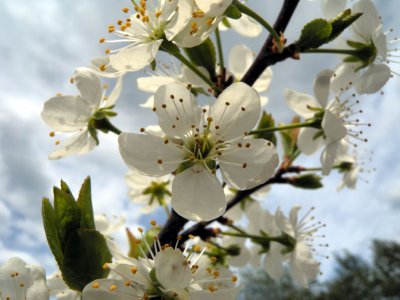

Wood... It is a vigorous plant (less often - moderate in growth).
Its height is usually 2.5 m or more. At the same time, the stem of the tree itself is relatively not very high.
The bark on the trunk of the plum is smooth to the touch, predominantly gray in color. Crown, branches... In an adult, a generally sparse (sometimes of medium density) tip is formed in the form of a slightly flat circle.
Largely spreading branches form a crown. The smooth bark of skeletal branches is gray in color. Escapes... Straightened (sometimes somewhat curved) shoots are distinguished by a rather thick section. The color of the shoots is light brown, some gloss is observed on the surface. A large number of small lentils are formed on the shoots.
Vegetative buds are very small in size, while fruit buds are medium in size. Leaves... Sizes are medium to large. The length of an ordinary leaf is 11 cm, width is 6 cm. The maximum expansion is observed closer to the apex.
The leaves grow ovoid. The main color is green, with a slight sheen. There are subtle wrinkles on the leaf surface. Inflorescences... Medium-sized white flowers bloom in cups.
The egg-shaped petals are 9 mm long and 7 mm wide. There is slight waviness on the edges of the petals. Usually 2-3 flowers are collected in one bud. Fruit... Fruits of yellow or light yellow color with a whitish waxy bloom are characterized by medium size, weighing in the range of 16-20 g.
The shape is generally rounded, there is a slight flattening. On the abdomen of the fetus, the seam is clearly visible. Under the thin skin, the flesh is yellow-green in color, rather loose, rich in juice.
Characteristics
- Entry into the fruiting period at Yellow Hopta occurs at the usual time - 4 years after planting a one-year-old seedling;
- the crop ripens in mid-late terms - in late August - early September;
- regular fruiting, no recessions were observed;
- one tree brings up to 10 - 13 kg of fruit, in large orchards this figure is 40 - 60 kg / ha;
- the ripe crop must be removed on time, otherwise the fruits may crumble;
- winter hardiness of the variety is excellent, especially for wood. In fruit buds, winter hardiness is slightly lower, at an average level;
- excellent adaptability of the plum allows it to be widely used in areas of risky farming, which are characterized by constant temperature drops, rainy and short summers;
- Yellow Hopty is self-fertile, therefore it requires a number of pollinators blooming at the same time as it;
- the immunity of the plum is average - it is moderately resistant to clotterosporia and hawthorn damage. Severely damaged by Maslov's seed eater;
- the tree is subject to damping, therefore, in especially snowy winters, you need to protect the trunk;
- transportation of fruits is poorly tolerated, their appearance can deteriorate greatly;
- the way of eating fruit is in its natural form. If you make jam or preserves from them, it is better to first remove the skin by pouring boiling water over them. For the same reason, the fruits of the Yellow Hopta are not suitable for compote.
Chinese variety of plum "Yellow Hopty" is recommended for cultivation in harsh climates


For many years now, breeders have been solving the most difficult task - the creation of such fruit varieties that, despite their original thermophilicity, would be able to give the inhabitants of the northern countries all the tenderness of their aroma and delicious the taste of southern fruits.
Along the way, many plum prospectors turn their close attention to numerous representatives Ussuri and Chinese selection.
And all thanks to the wide variety of their beneficial properties.
One of these plums, recommended for cultivation in regions with rather harsh climatic conditions, is the Chinese plum variety "Yellow Hopty".

